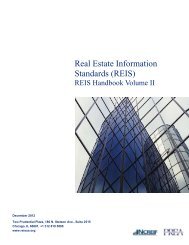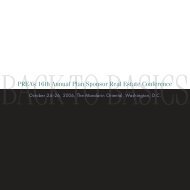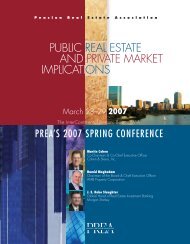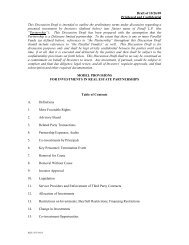Value Beyond Cost Savings - Green Building Finance Consortium
Value Beyond Cost Savings - Green Building Finance Consortium
Value Beyond Cost Savings - Green Building Finance Consortium
- No tags were found...
You also want an ePaper? Increase the reach of your titles
YUMPU automatically turns print PDFs into web optimized ePapers that Google loves.
Appendix FSustainable Property Financial Analysis AlternativesAnalysis/Model Description/Commentary Key Links/Examples• Road & bridgeconstruction/maintenance• More efficient use ofexistinginfrastructure<strong>Building</strong>s that are more energy efficient or generate a portionof their energy needs on-site can help reduce the need foradditional energy generation plants and expansion of thedistribution system. <strong>Building</strong>s that promote the use of publictransportation by workers or that have locations that can relyon existing transportation infrastructure can reduce oreliminate costs associated with additional construction andmaintenance of these improvements.Another cost consideration has to do with the duplication orunder-utilization of infrastructure improvements as a result ofurban sprawl. When new communities are developed outsideexisting urban areas the effect on infrastructure is twofold: 1)There must be a duplication of existing infrastructure alreadyin the urban area; and 2) Out-migration to the suburbs canleave the existing infrastructure under-utilized and reduce thenumber of taxpayers available to support these improvements.Several of the infrastructure cost benefit analyses use apresent value calculation to estimate the value of these publicbenefits. We believe this is a logical approach since buildingsthat incorporate these features will produce the benefits overmany years. Given the small impact of any particular building,presenting the total public benefits, and the relativecontribution of the subject building to costs is a good idea.Since infrastructure costs are not typically incremental, butrequire substantial expenditures to ensure excess capacity,often to meet peak demand, the marginal benefits to reducingpeak demand, a goal of many sustainable systems, can besignificantly higher than average costs.http://www.greenbuildingfc.com/Home/DocumentDetails.aspx?id=386Climate Change Economics has an interesting section laying out theBasic Economics of evaluating sustainability. This section, and theother key sections on issues in applying economic analysis areimportant for infrastructure and all public, and many private benefits ofsustainability.http://www.climatechangeecon.net/index.php?option=com_content&task=category§ionid=4&id=10&Itemid=22Water Collection, Storage, Treatment and Distribution: <strong>Cost</strong>-benefitstudy of 30 green schools in ten states calculates an average water-usereduction of 32%. The author translates this reduction in water-use andwastewater treatment into a net present value estimate (over 20 years)of $0.84/SF. [“<strong>Green</strong>ing America’s Schools – <strong>Cost</strong>s and Benefits,”Gregory Kats, October 2006, pg. 7]http://www.cap-e.com/ewebeditpro/items/O59F12807.pdfWater Supply & Wastewater Treatment: This report presents a netpresent value analysis (over 20 years) of avoided marginal water supplycosts and delayed expenditures from the construction of newwastewater facilities by the public sector. The study calculates anaverage “avoided” marginal water supply cost savings of $5,075 peracre foot, a wastewater facilities “avoided” cost savings of $953 peracre foot and a wastewater O&M “avoided” cost savings of $201 peracre foot. See, “The <strong>Cost</strong>s and Benefits of <strong>Green</strong> <strong>Building</strong>s,” GregoryKats, October 2003, pp 42-43:http://www.cap-e.com/ewebeditpro/items/O59F3259.pdf2. Environmental andResourceConservationBenefits• Conservation ofnatural environment• Landfill reductionEnvironmental & natural resource conservation benefitsanalyses seek to quantify public benefits associated with thosegreen building features that minimize the detrimental effects ofwater treatment and use, promote landfill reduction, cleanerair, cleaner water, and reduce drought risk.Resources from Waste: Integrated Resource Management is a verydetailed analytic study, which presents many creative quantitativetechniques to assess the costs and benefits of an integrated wastemanagement system. The study is an independent report on integratedresource management that examines approaches for localgovernments across British Columbia to use solid and liquid waste tocreate energy, reduce greenhouse gas emissions, conserve water, andrecover nutrients. Benefits cited include:Reduce greenhouse gas emissions by 25%249









